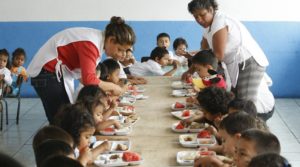Advances in the strategy for the prevention of chronic malnutrition in Guatemala
On 5 December, representatives of the member institutions of the Presidential Commission for the Reduction of Chronic Malnutrition met to evaluate actions undertaken in 2017 and to approve the timetable for implementation of the National Strategy for the Prevention of Chronic Malnutritionin the first semester…
 On 5 December, representatives of the member institutions of the Presidential Commission for the Reduction of Chronic Malnutrition met to evaluate actions undertaken in 2017 and to approve the timetable for implementation of the National Strategy for the Prevention of Chronic Malnutritionin the first semester of 2018, at the Secretariat of Food and Nutrition Security.
On 5 December, representatives of the member institutions of the Presidential Commission for the Reduction of Chronic Malnutrition met to evaluate actions undertaken in 2017 and to approve the timetable for implementation of the National Strategy for the Prevention of Chronic Malnutritionin the first semester of 2018, at the Secretariat of Food and Nutrition Security.
The Secretary of Food and Nutrition Security (SESAN), German González, said that each of the institutions and departmental Governors reported on actions taken in 2017 in the first phase of implementation of the National Strategy for the Prevention of Chronic Malnutrition in, in Huehuetenango, Quiché, Alta Verapaz and Chiquimula.
In these target departments, Departamental Food and Nutrition Committees (COMUSANs) prioritized 1471 communities and identified 42,930 children aged under two years and 51,768 households. Another of the achievements was to implement the pilot plan for training volunteers for monitoring children’s growth, which fosters the participation of the parents of the children identified. These volunteers will encourage behaviour change in such areas as breast and complementary feeding.
The meeting approved the timetable for actions to be undertaken in the first semester of 2018 in both the first and second phases of implementation of the strategy for the prevention of chronic malnutrition, which will include San Marcos, Totonicapán and Sololá. Work timetables have been approved since 2016, in order to gauge progress in each activity and know how the strategy is progressing.
Find out more about #ChronicMalnutrition here #Infografía. pic.twitter.com/NgLp3Z7jVG
— SESAN (@SecretariaSESAN) December 4, 2017
 Secretary González said, “This timetable will be presented to the President of the Republic, Jimmy Morales, for his approval. We have all agreed to implement actions as soon as possible, in early 2018. Since the target population has been identified, the ministries are going to need greater budgets in the medium term to reach the highest possible numbers of adults and children.”
Secretary González said, “This timetable will be presented to the President of the Republic, Jimmy Morales, for his approval. We have all agreed to implement actions as soon as possible, in early 2018. Since the target population has been identified, the ministries are going to need greater budgets in the medium term to reach the highest possible numbers of adults and children.”
Mr González concluded by saying that the strategy is based on the premise that all the institutions work together in a coordinated fashion or, in other words, the operation cannot be complete if one ministry is missing or one municipality is not working to prevent malnutrition.
The National Strategy for the Prevention of Chronic Malnutrition has the following programme axes: 1. Primary Health Care 2. Behaviour Change 3. Water and Sanitation 4. Availability of Food and Household Economy.
In a media statement, the Secretary of Food and Nutrition Security, German González, stated that compared to the previous year there had been one thousand fewer cases of acute malnutrition. The Secretary explained that as of 18 November 2017, there were 11,624 recorded cases of acute malnutrition, whereas on the same date in 2016, there had been 12,600, and he saw this as a step in the right direction.
Actions had included implementation of the Plan to Combat Seasonal Hunger, working with the Ministry of Agriculture, Livestock and Food (MAGA), the Ministry of Social Development (MIDES) and the Ministry of Public Health and Social Assistance (MSPAS), so that families could have better food and nutrition security and cases of acute malnutrition could be prevented.
#NACIONAL Strategy to combat malnutrition confirmed. @WFP_ES (World Food Programme) gives good news to @GuatemalaGob during meeting in Italy.https://t.co/7cm5A6i2ah pic.twitter.com/ISKlgxzSRE
— DCA Digital (@DiariodeCA) December 4, 2017
Informaciones Relacionadas
• National Strategy for the Prevention of Chronic Malnutrition
• Guatemala records 1000 fewer cases of acute malnutrition in 2017
• Strategy to combat malnutrition confirmed
• Progress presented in implementation of Strategy for the Prevention of Chronic Malnutrition